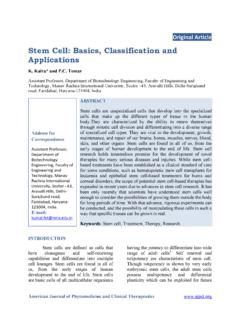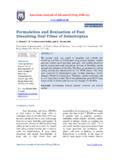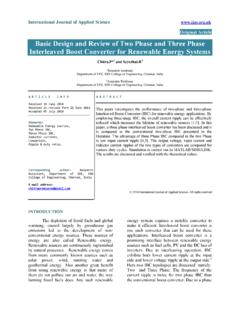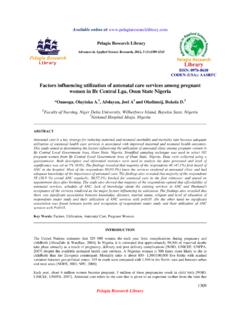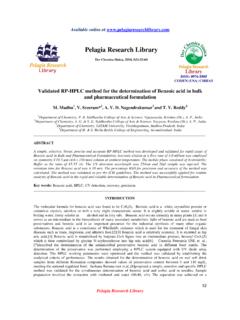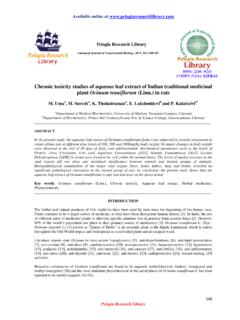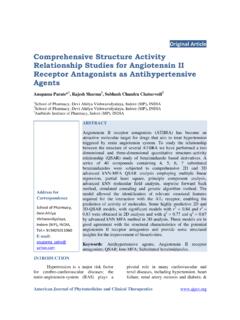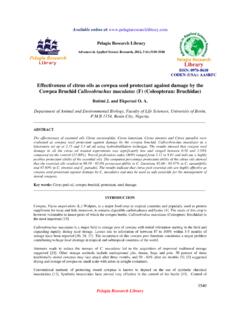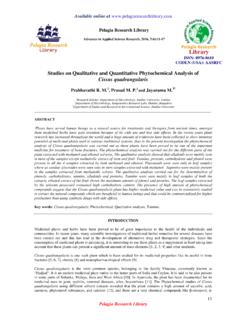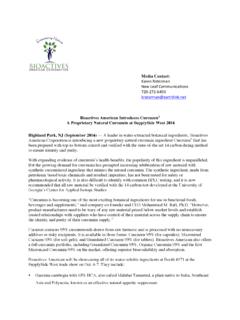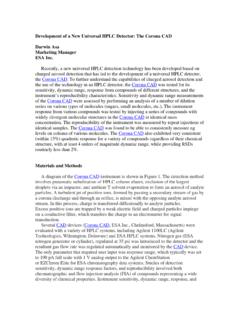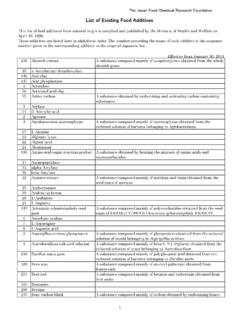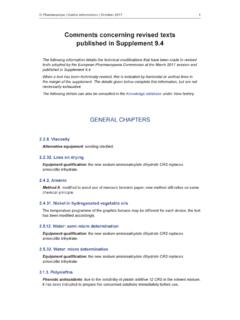Transcription of Plums: A Brief Introduction - iMedPub
1 Review Article iMedPub Journals 2017. Journal of Food, Nutrition and Population Health Vol. 1 No. 1: 8. plums : A Brief Introduction Preeti Birwal1, Deshmukh G1, Saurabh SP1 and Pragati S2. 1 Dairy Engineering, SRS of ICAR-National Dairy Research Institute (NDRI), Abstract Bangalore, Karnataka, India plums are important source of compounds influencing human health and 2 Indian Agricultural Research Institute preventing the occurrence of many diseases. plums have abundance of bioactive (IARI), New Delhi, India compounds such as phenolic acids, anthocyanin's, carotenoids, flavanols, organic acids, ( , citric and malic acids), fibre (pectin), tannins, aromatic substances, enzymes, minerals ( , potassium, phosphorus, calcium and magnesium, organic) Corresponding author: Preeti Birwal and vitamin A, B, C & K.
2 The predominant phenolic compounds in plums are caffeic acid, 3-O-caffeicquinic (neochlorogenic acid), 5-O-caffeicquinic (chlorogenic acid) and 4-O-caffe-icquinic (crypto-chlorogenic acid). plums are being used in Indian medicine as a component of natural drugs used in case of leucorrhea, irregular Scholar, Dairy Engineering, SRS of menstruation and miscarriage. Plum helps in prevention of heart disease, lung ICAR-National Dairy Research Institute and oral cancer, lower the blood sugar, blood pressure, Alzheimer's disease, (NDRI), Bangalore, India. muscular degeneration, improve memory capacity, boost bone health, regulates the functioning of the digestive system and so on. Incorporation of plums in dairy and food products like Yoghurt, Pies, Biscuits, Lassi, Ice cream etc.
3 , in form of Tel: 9896649633. extract, pulp, powder or dried chunks would surely boost up the nutritional and flavour quality. Keywords: Phenols; Anthocyanin's; Nutrition Citation: Birwal P, Deshmukh G, Saurabh SP, et al. plums : A Brief Introduction . J Food Nutr Popul Health. 2017, 1:1. Received: February 03, 2017; Accepted: March 06, 2017; Published: March 16, 2017. Introduction to improve the process efficiency and desirable product quality. So, for increased globalization and consumer awareness it is plums are one of the most important stone fruits crops of the necessary to minimize the detrimental effects such as physical and world. plums also include several familiar stone fruits- apricot, chemical changes during of plums .
4 In traditional air drying process cherry and peach. There are more than 2000 varieties of plums , plums undergo oxidative damage, browning, loss of flavour and among which relatively few are of commercial importance [1]. shrinkage, which lead to lower sensory and nutritional quality These are grown in temperate zone in which China, Romania and of the products. To improve product quality and reduce drying are leading countries for the production of plums [2]. time, osmotic dehydration can be an advantageous method for plums are important source of compounds influencing human plum drying. It is a pre-treatment for fruits and vegetables prior health and preventing the occurrence of many diseases [3]. These to drying [5] and other heat assisted processing like canning, are mostly consumed fresh all over the world.
5 The processing of freezing, and minimal processing as osmotic dehydration does plums is generally relies on drying of fresh plum, canning and not lowers the product moisture [6]. beverage preparation. Although sun drying was very common The purpose of this paper is to review the physical characteristics, earlier, today plums are mostly dehydrated [4]. plums have high health benefits, nutritional and antioxidant properties of plums . sugar content, so to maintain the nutritional and sensory quality, dehydration to desired moisture content, sub atmospheric Historical Background conditions are desirable. Different conventional and novel drying With many know varieties of plums , it is not surprising that it techniques are applied for drying of plums such as hot air drying, has different heritages and places of origin in all over the world.
6 Sun drying, vacuum drying, microwave drying, high pressure The practice of cultivation has been done since prehistoric assisted drying and osmotic dehydration. Drying of plums is times, longer perhaps than any other kind of fruit except the usually done for attainment of low microbial loads and to make apple. Earliest known data of plums says that plums are origin more stable product to provide stability throughout the year. of China, 470 BC. The European plums are thought to have been Increased competition in today's global market refers avenues discovered around two thousand years ago, originating in the Under License of Creative Commons Attribution License | This article is available in: 1. 2017. Journal of Food, Nutrition and Population Health Vol.
7 1 No. 1: 8. area near the Eastern Europe or Western Asia. In ancient Roman of plums in recent years [13]. These fruits constitute rich source times, 300 varieties of European plums were mentioned. The of antioxidant compounds, such as phenolic acids, anthocyanins pilgrims introduced the European plums to United States in 17th and other flavonoids [11,14]. century. Japanese plums actually originated in China rather than The predominant phenolic compounds in plums are derivatives Japan. It was introduced to Japan 200-400 years ago [7], from of caffeic acid: 3-O-caffeicquinic (neochlorogenic acid), which it disseminated around the world. plums may have been 5-O-caffeicquinic (chlorogenic acid) and 4-O-caffe-icquinic one of the first fruits domesticated by humans.
8 Plum remains (cryptochlorogenic acid) as well as caffeic acid, together with have been found in Neolithic age archaeological sites along with smaller amounts of anthocyanins, flavanols and flavonols [11]. olives, grapes and figs. Today plum is cultivated in all temperate climate countries of the world. Europe first bred European According to literature data, depending on the variety, plum (Prunusdomestica), America first had the American plum environmental conditions and applied analytical methods, (Prunus Americana), South Asia cultivated the cherry plum contents of phenolic acids in plums fall within a wide range of (Prunuscerasifera), and Western Asia is having the Damson plum values (Table 2) [9,15-17].
9 (Prunussalicina). Fruit processing affects polyphenol contents and alters fruit microstructure, resulting in the loss or enrichment of some Characteristics of plums polyphenols and influencing their access and availability [18-21]. plums are a drupe fruit of the subgenus Prunus of the genus (Table 3). Prunus. Weinberger, (1975) reported nearly 2000 species in genus prunus. They come in a wide variety of size and colors like Health-Promoting Properties of plums yellow, white, green or red flesh. Mature plum fruit may have a Numerous studies confirmed the health-promoting action of dusty-white coating that gives them a glaucous appearance [8] plums as a dietary component. Followings are summarized some (Table 1).
10 Health benefits of plums (Table 4). plums have abundance of bioactive compounds such as phenolic acids, anthocyanins, carotenoids, minerals and pectins. For Processing of plums many decades plums have been used in Indian medicine as a There is old saying that All dried plums are prunes but not component of natural drugs used in case of leucorrhea, irregular all plums are prunes . plums with high sugar content and firm menstruation and miscarriage [9]. Nutrients present in plum flesh dried without removal of stone and are called prunes [7]. determine nutritive value and taste of plums [10]. plums are being processed in different kind of products and are Nutritional Value of plums Table 1 Scientific classification of plums .

